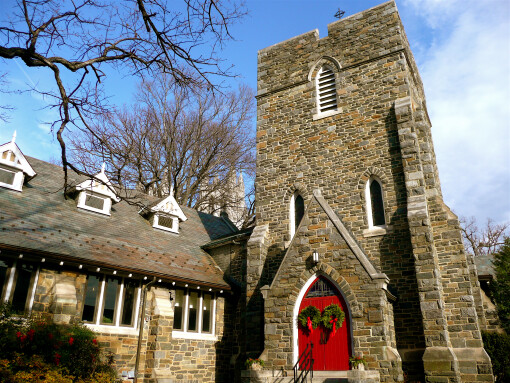The Hidden God

Series: Advent
Speaker: The Rev'd Jim Quigley
In the name of the Father, the Son and the Holy Spirit, AMEN
Today we begin the astounding season of Advent in the church. I say astounding because Advent is a season when we wait for nothing less than the miraculous. Advent is the season we pray for the coming of God’s Kingdom in this world – thy Kingdom come thy will be done on earth as it is in heaven! We hope and we pray that God will finally break in. That God will finally break through! I can’t think of a better place to begin the journey than with our reading from Third Isaiah. When I teach about the book of Isaiah I remind people that it’s a book written by three distinct authors writing about the ways of God in three distinct historical contexts. The book of the prophet Isaiah took 232 years to write!
First Isaiah was a castigator, writing to the people of Israel around 700 b.c.e when the Northern Kingdom of Israel was annexed to the Assyrian empire. The message of First Isaiah was a prophetic condemnation written to a people gone astray from the ways of their God, a word declaring the fall of the Northern Kingdom as God’s punishment for Israel’s apostasy.
Second Isaiah was a comforter, a prophet whose message was pure consolation. The message of Second Isaiah is a love letter written to the people of Israel a couple hundred years later, just before the fall of Babylon to the armies of Cyrus, King of Persia (October 29, 539 b.c.e). Second Isaiah addresses a people in exile, those longing for deliverance from captivity: “Comfort, O comfort my people, says your God. Speak kindly to Jerusalem; and call out to her, that her warfare has ended, that her iniquity has been removed, that she has received of the Lord’s hand double for all her sins. A voice is calling, Clear the way for the Lord in this wilderness; make smooth in this desert a highway for our God!”
Third Isaiah was a questioner. Third Isaiah wrote a decade or two after Second Isaiah and the message of his was neither condemnation nor consolation but lamentation. “We all have become like one who is unclean, and all our righteous deeds are like a filthy cloth. We fade like a leaf and our iniquities, like the wind, take us away… for you have hidden your face from us and have delivered us into the hand of our iniquity... And yet, O Lord, you are our Father.”
The lament of Third Isaiah is part of a larger unit that begins in chapter 63 with a recollection of God’s deeds in the past, God’s fiery presence as a redeemer, the mighty One who delivered the people of Israel from bondage in Egypt. Taken together in this larger context, the opening verses of the passage we read today are Isaiah’s pleading for that saving presence to come again: “O that you would tear open the heavens and come down!” Isaiah is calling on the God of ancient history, the God of the Exodus, the God who “heard the cry of God’s people” and intervened on Israel’s behalf. But in Third Isaiah’s day, the God of the Exodus was in hiding. Where are you, Lord? The hidden God of third Isaiah is like a parent practicing tough love, this time refusing to rescue Israel from their distress. Theologically speaking the lament of third Isaiah raises profound questions about the very nature of God’s ways in the world. Does God act one way at one moment and differently in another or is God the same yesterday today and forever?
I can’t imagine that there are any of us here this morning who have not wondered the very same. Third Isaiah is a frustrated believer looking for a reasonable and holy hope, putting it mildly. He’s searching for answers and desperately trying to reconcile the God of his tradition with the seemingly absent God in the present. Is God strong to deliver? The question of third Isaiah is like that of the young of Elie Wiesel at a concentration camp in Buchenwald, who when seeing a Jewish child hanging from the gallows asked, “Where is God now?” O that you would just come down! God saved the Israelites from Pharaoh so why not Hitler? How can we remain faithful if our own suffering and the suffering of our age seem beset with a God who’s gone AWOL?
As Elie Weisel saw a fellow Jew hanging on those gallows in Buchenwald Christian theologian Dietrich Bonhoeffer wrote from his jail cell in Tegel: “God would have us know that we must live as men who manage our lives without him (Letters and Papers from Prison).” That’s a rather remarkable claim, but it’s part of the reality of what it means to be in relationship with the God of Israel and the God and Father of our Lord Jesus Christ. Eloi, Eloi, lema sabachtani? “Before God and with God we live without God,” Bonhoeffer writes. As incarnate in our savior Jesus Christ, “God let’s himself be pushed out of the world and onto the cross. [God] is weak and powerless in the world and that is the way, the only way, [God] is with us and helps us.” That’s the astounding end to the Advent of God in history, in the redeeming of our time. Remaining faithful in the midst of adversity is not as much about understanding what God might or could do as much as it is about understanding what God doesn’t, or will not do.
I’m deeply engrossed in Volume One of Katherine Sonderegger’s Systematic Theology. It’s an extraordinary work that paints a picture of God’s nature through the lens of Holy Scripture. In it she reaches back to biblical texts that we don’t pay much attention to, like the book of Numbers, reminding us that we will not travel far in the school of scripture if we don’t wander the wilderness road of the Old Testament; if we dismiss these ancient texts as ‘primitive religion’ soon to be supplanted by a more favorable rationalism or scholasticism or progressivism, a God of Wrath now thankfully supplanted by a New Testament God of Love. “Such cheap reading of the Bible can never undergird a serious theological encounter with the Word of the Lord,” she brilliantly writes. If I understand what she’s trying to say I think that she comes to the same conclusion as Bonhoeffer: God’s power lies in God’s weakness in the world, or said in another way in God’s vulnerability to the world. The way of God is the way of vulnerable, non-coercive love – humble, wise, omnipresent, omnipotent, omniscient, eternal, and surpassing glorious love.
In the midst of his lament Third Isaiah hints at the same kind of understanding. After a plea for the all-powerful God, the God of Israel’s past, to tear open the heavens and come down so that the mountains would quake at God’s presence in the face of Israel’s adversaries, he shifts his position and admits that despite what he wants, God is the Father. And not only is God a Father but God is also a potter. An artist. A maker. I read that transition in the text as a call to obedience akin to the words of Jesus in the garden of Gethsemane: “Despite what I am hoping for, O Lord, you are our Father, we are the clay and you are the potter, we are all the work of your hand, mold us, teach us your way. Shape us! Not our will but yours be done.
We’ll end with a prayer: Heavenly Father, in our customary time in response to the gospel we invite you, our maker and our redeemer, to remold us in new way. In your way, as you will. May your hidden word guide us and reshape our hearts and minds, and all to the glory of your name.
Amen.
 Welcome to St. Alban’s Church! Every Sunday, and most days in between, people gather in this place to worship, to learn, to grow, to share the joys and struggles of our lives, and to seek God’s grace in the midst of our lives. We do not come because we have it all figured out, but because we are seeking light on the way. We come as we are and welcome one another.
Welcome to St. Alban’s Church! Every Sunday, and most days in between, people gather in this place to worship, to learn, to grow, to share the joys and struggles of our lives, and to seek God’s grace in the midst of our lives. We do not come because we have it all figured out, but because we are seeking light on the way. We come as we are and welcome one another.

